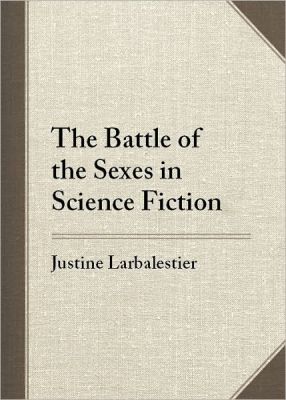

| THE BATTLE OF THE SEXES IN SCIENCE FICTION Justine Larbalestier Middletown, CT: Wesleyan University Press, June 2002 |
Rating: 4.0 High |
|||
| ISBN-13 978-0-8195-6526-6 | ||||
| ISBN 0-8195-6526-1 | 295pp. | HC | $65.00 | |
"This book is about a type of story, the battle-of-the-sexes story, and how such stories provide insight into the role of women in science fiction, literally and textually, from the mid-1920s until the present. It is equally about the battle of the sexes as it was played out in what Samuel R. Delany calls "the vast tributary system of informal criticism" (Delany 1984: 238). In the pages that follow, you will see that letters, reviews, fanzines, and marketing blurbs are as important as the stories themselves in understanding the evolving relationship between men and women in sf." – Page 1 |
Indeed, the published fiction makes up the smallest portion of her source material. She focuses on a relatively small number of stories within the genre of science fiction: stories she [implicitly] defines as portraying some sort of institutionalization of male-female conflict. These stories involve some sort of segregation of the two genders3. That segregation could be by status: females relegated to secondary status — or a literal segregation. And that could either be intentional, as in "The Last Man" (Wallace West, 1929) where one gender exterminates the other, or accidental. Accidental segregation encompasses unintentional extermination, due to causes such as war or plague, and original isolation due to separate origins. In the latter case the writer's intent is often to contrast normal relations between the genders with the reaction to some idealized form discovered at the remote location: a distant planet, say.
As I read Larbalestier's analysis of these stories, I had the impression she sought to demonstrate that mutual gender hostility was the rule during this period. That was especially true in the Introduction and the opening chapters (1-3), where her apparent goal is to demonstrate that science fiction excludes female characters to the extent possible, and that where they do appear, they are part of what she calls the "heterosexual economy" — that is, willingly subservient to men and frequently there only to serve as the "love interest." This is certainly true of the stories by male writers she selects, even when they portray female-dominant worlds. By breaking down passages word by word and analyzing the use of pronouns, she claims to show that these female societies actually take on the characteristics of the male hegemony they are supposed to have eliminated.
Even when the stories purport to show equality, she finds it is a sham fairness which actually restores what she calls "the heterosexual economy." By this she means the traditional patriarchal arrangement in which men are dominant and women submissive. She seems to take a morose kind of satisfaction in pointing out how often a female-only or female-dominated society greets male visitors from Earth with adoration and lust. Similarly, when priestess Meg reacts with discomfiting passion to Daiv's kiss in "The Priestess Who Rebelled" (Nelson S. Bond, 1939), the author denigrates the scene as a stereotypical evocation of the way women instantly and willingly take a subservient position when a Real Man appears. Even when the roles are reversed, as in "The Last Man", Larbalestier finds the female world depicted taking on the characteristics of traditional male societies.
Perhaps I'm being unfair in ascribing to Larbalestier some sort of feminist agenda. Certainly there is ample justification for the view that science fiction published in books and magazines during those early years typically was a bastion of male supremacy in which female characters appeared seldom, and then only as the love interest or as victims whom the males rescued from some calamity. However, this was not universally true even of the male writers. Also there were women writing science fiction throughout the period, and quite a number of women reading it (though not a majority.) Nor were the female readers shy about expressing their opinions in the letters columns of the magazines. Larbalestier shows that the editors generally welcomed female readers, but she views them as condescending.
The period from 1926 through 1973 was a time of great change in science fiction, much of which Justine Larbalestier appears to overlook. She ignores important stories, misinterprets a number of passages in the texts she cites, and sometimes contradicts herself. Despite these faults, the book has value: it probes a number of obscure stories, gives us glimpses of many fans who later became important writers, like Isaac Asimov, and reveals the life (or lives, as Larbalestier would say) of Alice Sheldon. But overall the book is confusingly jargon-laden, and I found it very hard to get through. Also, it overstates its case. I'll give it a rating of 4. I only recommend it for scholars and ardent fans of the works of Alice B. Sheldon (which works include the persona James Tiptree Jr.)
The book is Volume 4 of the Wesleyan Early Classics of Science Fiction series. The hardcover edition is unjacketed, per Wesleyan University Press. I show the paperback cover image on my Errata page. The cover art is by Gabriel Mayorga.

 To contact Chris Winter, send email to this address.
To contact Chris Winter, send email to this address.